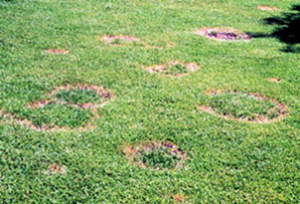Necrotic Ring Spot
Necrotic ring spot is caused by a fungus known as leptosphaeri korrae. Necrotic ring spot frequently occurs on 2-5 year old sodded lawns, and is prevalent in vigorously growing lawns. These lawns often develop a thick thatch layer, which stimulates fungal growth. Necrotic ring spot is also common in lawns that have layered soil; one to two inches of topsoil laid down over hard compacted native soil, but not mixed together. This effect produces a lawn with shallow roots and poor drainage.

The disease is spread by plant to plant contact or mechanically with lawn equipment. The fungus becomes active during cool, wet periods in the spring and again in the fall. The first symptoms, which are rarely observed, are reddish brown to straw colored grass blades. Usually, the disease is not detected until many plants are killed, forming small circular patches of dead, straw-colored grass. The center of the patch is often recolonized by healthy grass, creating rings of dead grass that resemble “frog-eyes” or donuts”. Multiple rings often coalesce, forming irregular patterns in the lawn. Damage is most evident in the summer, even though the fungus is not active at this time. During hot, dry weather, damaged root systems can no longer support the plant and the entire plant dies.

Necrotic ring spot can be problematic, but implementation of proper cultural practices can manage this disease. However, if cultural deficiencies are not corrected, necrotic ring spot may persist in a lawn for many years. Lawns that are compacted or have thick thatch layers promote the development of necrotic ring spot. Once the disease symptoms are visible fungicides are of little help. Symptoms of necrotic ring spot are similar to those of other lawn diseases, especially summer patch.
L.C.S Solution
- Aeration should be done yearly (in some cases twice a year) to reduce soil compaction, and help reduce the thatch layer.
- Proper fertilization and watering will help keep the grass healthy. Watering diseased areas in summer is different than normal watering recommendations, it should be light, frequent watering (3-4 times per week) do to the shallow roots caused by the disease. Spring and fall should be back to normal watering patterns.
- Seeding the affected areas with resistant varieties of grass will help it recover faster.
